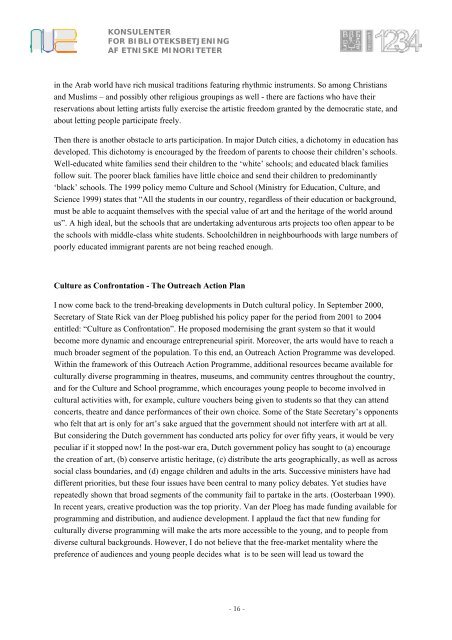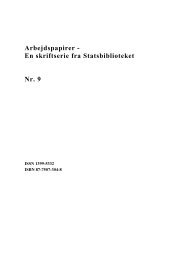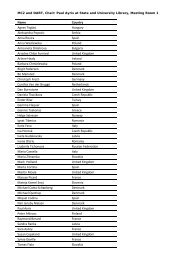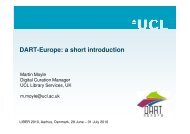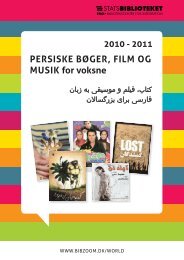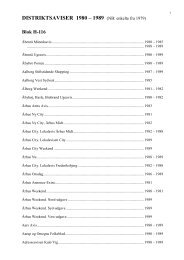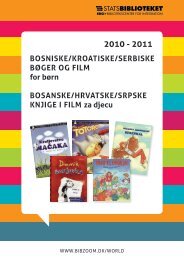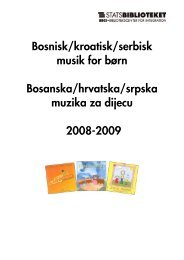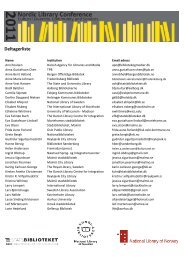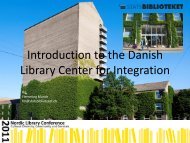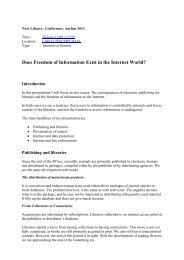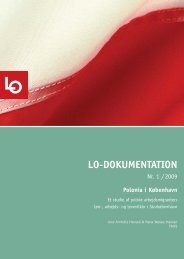Konference om Integration, kultur og biblioteker - Statsbiblioteket
Konference om Integration, kultur og biblioteker - Statsbiblioteket
Konference om Integration, kultur og biblioteker - Statsbiblioteket
You also want an ePaper? Increase the reach of your titles
YUMPU automatically turns print PDFs into web optimized ePapers that Google loves.
KONSULENTER<br />
FOR BIBLIOTEKSBETJENING<br />
AF ETNISKE MINORITETER<br />
in the Arab world have rich musical traditions featuring rhythmic instruments. So among Christians<br />
and Muslims – and possibly other religious groupings as well - there are factions who have their<br />
reservations about letting artists fully exercise the artistic freed<strong>om</strong> granted by the democratic state, and<br />
about letting people participate freely.<br />
Then there is another obstacle to arts participation. In major Dutch cities, a dichot<strong>om</strong>y in education has<br />
developed. This dichot<strong>om</strong>y is encouraged by the freed<strong>om</strong> of parents to choose their children’s schools.<br />
Well-educated white families send their children to the ‘white’ schools; and educated black families<br />
follow suit. The poorer black families have little choice and send their children to pred<strong>om</strong>inantly<br />
‘black’ schools. The 1999 policy memo Culture and School (Ministry for Education, Culture, and<br />
Science 1999) states that “All the students in our country, regardless of their education or background,<br />
must be able to acquaint themselves with the special value of art and the heritage of the world around<br />
us”. A high ideal, but the schools that are undertaking adventurous arts projects too often appear to be<br />
the schools with middle-class white students. Schoolchildren in neighbourhoods with large numbers of<br />
poorly educated immigrant parents are not being reached enough.<br />
Culture as Confrontation - The Outreach Action Plan<br />
I now c<strong>om</strong>e back to the trend-breaking developments in Dutch cultural policy. In September 2000,<br />
Secretary of State Rick van der Ploeg published his policy paper for the period fr<strong>om</strong> 2001 to 2004<br />
entitled: “Culture as Confrontation”. He proposed modernising the grant system so that it would<br />
bec<strong>om</strong>e more dynamic and encourage entrepreneurial spirit. Moreover, the arts would have to reach a<br />
much broader segment of the population. To this end, an Outreach Action Pr<strong>og</strong>ramme was developed.<br />
Within the framework of this Outreach Action Pr<strong>og</strong>ramme, additional resources became available for<br />
culturally diverse pr<strong>og</strong>ramming in theatres, museums, and c<strong>om</strong>munity centres throughout the country,<br />
and for the Culture and School pr<strong>og</strong>ramme, which encourages young people to bec<strong>om</strong>e involved in<br />
cultural activities with, for example, culture vouchers being given to students so that they can attend<br />
concerts, theatre and dance performances of their own choice. S<strong>om</strong>e of the State Secretary’s opponents<br />
who felt that art is only for art’s sake argued that the government should not interfere with art at all.<br />
But considering the Dutch government has conducted arts policy for over fifty years, it would be very<br />
peculiar if it stopped now! In the post-war era, Dutch government policy has sought to (a) encourage<br />
the creation of art, (b) conserve artistic heritage, (c) distribute the arts ge<strong>og</strong>raphically, as well as across<br />
social class boundaries, and (d) engage children and adults in the arts. Successive ministers have had<br />
different priorities, but these four issues have been central to many policy debates. Yet studies have<br />
repeatedly shown that broad segments of the c<strong>om</strong>munity fail to partake in the arts. (Oosterbaan 1990).<br />
In recent years, creative production was the top priority. Van der Ploeg has made funding available for<br />
pr<strong>og</strong>ramming and distribution, and audience development. I applaud the fact that new funding for<br />
culturally diverse pr<strong>og</strong>ramming will make the arts more accessible to the young, and to people fr<strong>om</strong><br />
diverse cultural backgrounds. However, I do not believe that the free-market mentality where the<br />
preference of audiences and young people decides what is to be seen will lead us toward the<br />
- 16 -


